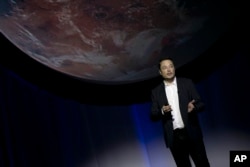Elon Musk's SpaceX on Thursday salvaged half of the $6 million nosecone of its rocket, in what the space entrepreneur deemed an important feat in the drive to recover more of its launch hardware and cut the cost of space flights.
Shortly after the main section of SpaceX's first recycled Falcon 9 booster landed itself on a platform in the ocean, half of the rocket's nosecone, which protected a communications satellite during launch, splashed down via parachute nearby.
"That was the cherry on the cake," Musk, who serves as chief executive and lead designer of Space Exploration Technologies, told reporters after launch from NASA's Kennedy Space Center in Florida.
Measuring 43 feet (13 meters) long and 17 feet (5 meters) in diameter, the nosecone is big enough to hold a school bus. It separates into two pieces, exposing the satellite, about 4 minutes after liftoff.
As a test, SpaceX outfitted the fairing with thrusters and a steerable parachute.
"It's its own little spacecraft," Musk said. "The thrusters maintain its orientation as it re-enters and then ... the parachute steers it to a particular location."
SpaceX has focused most of its efforts and more than $1 billion into developing technologies to recover the Falcon 9's main section, which accounts for about 75 percent of the $62 million rocket. Musk's goal is to cut the cost of spaceflight so that humanity can migrate beyond Earth.
"I hope people will start to think about it as a real goal to establish a civilization on Mars," he said.
Landing on 'bouncy castle'
After some debate about whether the nosecone could be recovered, Musk said he told his engineering team, "Imagine you had $6 million in cash on a pallet flying through the air that's just going to smash into the ocean. Would you try to recover that? Yes, you would."
Musk envisions deploying a kind of "bouncy castle" for the fairing to land on so it can be recovered intact and reused.
The company plans up to six more flights of recycled boosters this year, including two that will strapped alongside a third, new first stage for the debut test flight of a heavy-lift rocket.
Originally slated to fly in 2013, Falcon Heavy is now expected to fly late this summer.
"At first it sounded easy: We'll just take two first stages and use them as strap-on boosters," Musk said. "It was actually shockingly difficult to go from single core to a triple-core vehicle."
SpaceX also may try to land the rocket's upper-stage section, a feat the company has never attempted. "Odds of success low, but maybe worth a shot," Musk wrote Friday on Twitter.
Privately owned SpaceX also is developing a commercial space taxi to fly astronauts to the International Space Station, a venture to send two space tourists on a trip around the moon and a Mars lander that is slated to launch in 2020.













